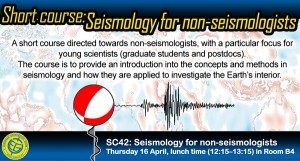Do you have difficulty in understanding results inferred from seismological studies? A dedicated short course directed towards non-seismologists, with a particular focus for young scientists (graduate students and postdocs), is being held during this year’s EGU general assembly
The main goal of the course is to provide an introduction into the concepts and methods in seismology and how they are applied to investigate the Earth’s interior. The course will also highlight the role that advanced seismological analysis techniques can play in the co-interpretation of results from other fields in the geosciences, such as tectonics, geology and geodynamics. Topics covered will include the discussion of powerful seismic analysis tools (e.g., receiver functions and tomography), interpretation of seismic anisotropy, and mechanics of the seismic source. The intention is to discuss each topic in a non-technical manner, emphasizing their respective strengths (and potential shortcomings) in regards to model interpretation. Not only will this course help non-seismologists to better understand seismic results and their interpretation, but also facilitate more enriched discussion between the geosciences. The 1 hour short course will be run by fellow young seismologists, who will present examples from their own research for illustration. Questions from the audience will be encouraged.
This short course is open for everyone, for free, however, early registration is strongly encouraged.
Date: Thursday, 16th April 2015
Time: 12:15–13:15 (during lunch time break)
Room: B4
Website: http://meetingorganizer.copernicus.org/EGU2015/session/19507
Registration (free): https://docs.google.com/forms/d/...
Add this session to your Personal Programme.
The short course is convened by: Matthew Agius, Andrew Schaeffer, Andrea Licciardi, Pierre Arroucau, Sebastiano D’Amico, Eve Tsang-Hin-Sun, Alexandra Moshou, Stephen Beller, Charlotte Fillon.


philippe grange
I ll be very interested by this course
Pingback: » What’s up? The Friday links (77)